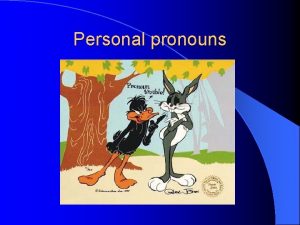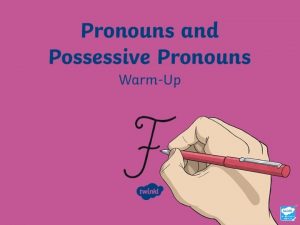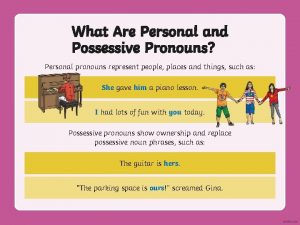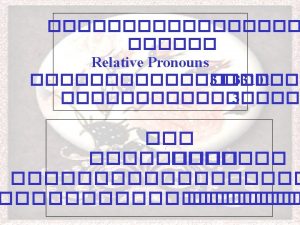Personal pronouns Personal Pronouns Pronouna word used to






![How do they decline? Person Number 1 2 3 [m] 3[f] 3[n] English I How do they decline? Person Number 1 2 3 [m] 3[f] 3[n] English I](https://slidetodoc.com/presentation_image/20a7f0c41b6747c07f629b0ef183145d/image-7.jpg)









![idem, eadem, idem [the same] l This adjective meaning “the same” declines like is, idem, eadem, idem [the same] l This adjective meaning “the same” declines like is,](https://slidetodoc.com/presentation_image/20a7f0c41b6747c07f629b0ef183145d/image-17.jpg)

- Slides: 18

Personal pronouns

Personal Pronouns Pronoun-a word used to take the place of a noun Antecedent = the preceding noun which the pronoun replaces money. EXAMPLE: Marcus carefully hid the money You will not find it without care.

Many pronouns have antecedents, words which come before the pronoun to which the pronoun refers. A pronoun and its antecedent must agree in number. If the antecedent is singular, then the pronoun must also be singular. If the antecedent is plural, the pronoun must be plural. Consider these sentences: l Freddy Frog jumped into his pond. l (The antecedent of the pronoun his is Freddy. ) l When Tom Turtle saw what a nice pond it was, he decided to toddle over. (The antecedent of it is pond. ) l Freddy Frog and Tom Turtle jumped into their pond. (The antecedent of the pronoun their is Freddy Frog and Tom Turtle. )

As with Latin nouns, personal pronouns have: CASE - shows the pronoun’s function in the sentence NUMBER - singular or plural GENDER – masculine, feminine, or neuter N. B. 1 st and 2 nd person pronouns DO NOT have neuter gender. Why not? ANSWER

Since the 1 st person pronoun is “I” or “we” and the 2 nd person pronoun is “you”, people will not be neuter gender

What are the personal pronouns? English Latin 1 st person s. l 2 nd person s. l 3 rd person s. – Masculine - Feminine - Neuter I You ego tu he she it is ea id 1 st person pl. l 2 nd person pl. l 3 rd person pl. We You They nos vos ei [m] eae [f] ea [ n] l l
![How do they decline Person Number 1 2 3 m 3f 3n English I How do they decline? Person Number 1 2 3 [m] 3[f] 3[n] English I](https://slidetodoc.com/presentation_image/20a7f0c41b6747c07f629b0ef183145d/image-7.jpg)
How do they decline? Person Number 1 2 3 [m] 3[f] 3[n] English I You He She It Singular Nom. ego tu is ea id Gen. mei tui eius Dat. mihi tibi ei ei ei Acc. me te eum eam id Abl. me te eo eā eo Nom. nos vos ei eae ea Gen. nostrum/ vestrum/ eorum nostri vestri earum eorum Dat. nobis vobis eis eis Acc. nos vos eas ea Abl. nobis vobis eis eis Plural Case

What case do I use? l Pronouns agree with their antecedents in: – Gender – Number BUT… l Case comes from the use in the clause For example: The farmer works in the fields daily. I often see him. The noun “farmer” is the antecedent of “him”, therefore you need masculine singular, BUT… “him” is the direct object, so you use the accusative case. The correct Latin form is eum.

Remember: l Not all pronouns have antecedents, – For example: Marcus walking with us. [“us has no antecedent] l You are I will be friends forever. [neither “you” nor “I” has an antecedent] l

Ok. Your turn… determine the correct Latin form Does the girl like him? Answer Where is her mother? Answer Will you please go with me? Answer Flavia has a surprise for you [s. ]. Answer He and I work well together. Answer

l Eum l Because “him” is: l 3 rd person, singular l masculine l a direct object and needs to be accusative BACK

l Eius l Because “her” is: l 3 rd person, singular l feminine l possessive and needs to be genitive BACK

mecum l Because “me” is: l 1 st person, singular l masculine [always assume masc. gender if you do not know] l object of preposition “with”and needs to be ablative BACK

l tibi l Because “to you” is: l 2 nd person, singular l masculine l an indirect object and needs to be dative BACK

Ego et Is l Because “he” is: l 3 rd person, singular l Masculine l “I” is l 1 st person, singular l masculine l they are subjects and need to be nominative

Great work l Now, let’s look at a compounded form of is, ea, id which is an adjective meaning, “the same”
![idem eadem idem the same l This adjective meaning the same declines like is idem, eadem, idem [the same] l This adjective meaning “the same” declines like is,](https://slidetodoc.com/presentation_image/20a7f0c41b6747c07f629b0ef183145d/image-17.jpg)
idem, eadem, idem [the same] l This adjective meaning “the same” declines like is, ea, id, but adds the –dem suffix l This suffix causes a few slight spelling changes to make the resulting word easier to say: – The acc. singular and genitive plural forms of is, ea, id end with the letter –“m”; the –“m”, changes to –“n”. Acc. s. eundem, eandem, idem l Gen. pl. eorundem, earundem, eorundem l

The Paradigm SINGULAR M F NOMINATIVE idem eadem GENITIVE eiusdem DATIVE eidem ACCUSATIVE eundem eandem ABLATIVE eodem eadem N idem eiusdem eidem eodem PLURAL NOMINATIVE eidem eaedem GENITIVE eorundem earundem DATIVE eisdem ACCUSATIVE eosdem easdem ABLATIVE eisdem eadem eorundem eisdem eadem eisdem eidem pueri- the same boys [nom. plural] eandem puellam- the same girl [acc. singular]
 Pronouna
Pronouna Possessive and personal pronouns
Possessive and personal pronouns Personal and possessive
Personal and possessive Relative possessive pronoun
Relative possessive pronoun Subject object and reflexive pronouns
Subject object and reflexive pronouns Interrogative and demonstrative pronouns
Interrogative and demonstrative pronouns Interrogative demonstrative pronouns
Interrogative demonstrative pronouns Reflexive pronouns and reciprocal pronouns exercises
Reflexive pronouns and reciprocal pronouns exercises Reflexive pronouns function
Reflexive pronouns function 8 subject pronouns
8 subject pronouns Decide whether the relative pronouns must be used or not
Decide whether the relative pronouns must be used or not How are the underlined pronouns under reflexive used
How are the underlined pronouns under reflexive used Intensive pronoun
Intensive pronoun Used to describe nouns and pronouns
Used to describe nouns and pronouns In a premix burner used in fes the fuel used is
In a premix burner used in fes the fuel used is In a premix burner used in fes the fuel used is
In a premix burner used in fes the fuel used is Alliteration in persuasive writing
Alliteration in persuasive writing Cases of pronoun
Cases of pronoun Subjective pronouns examples
Subjective pronouns examples



































